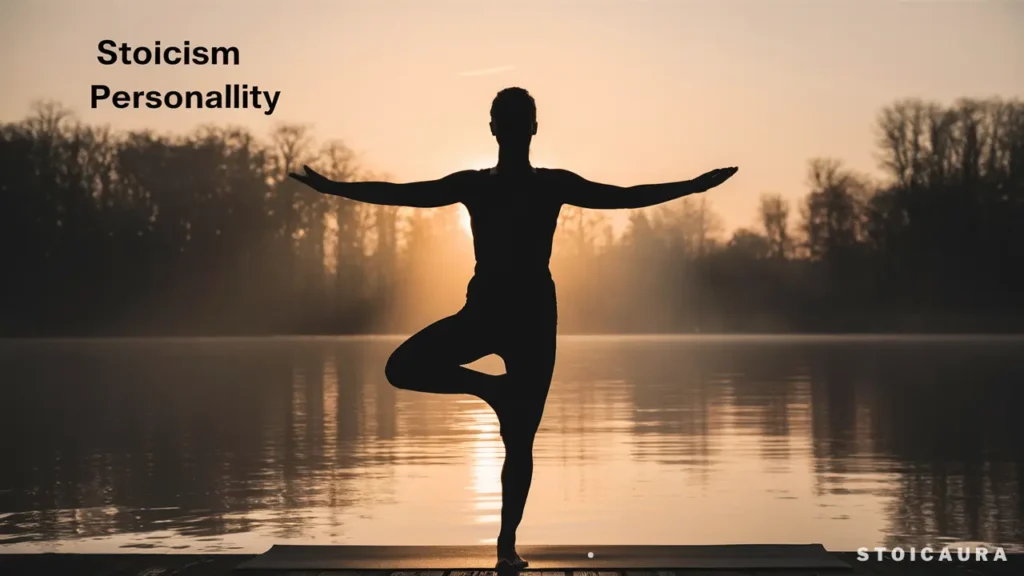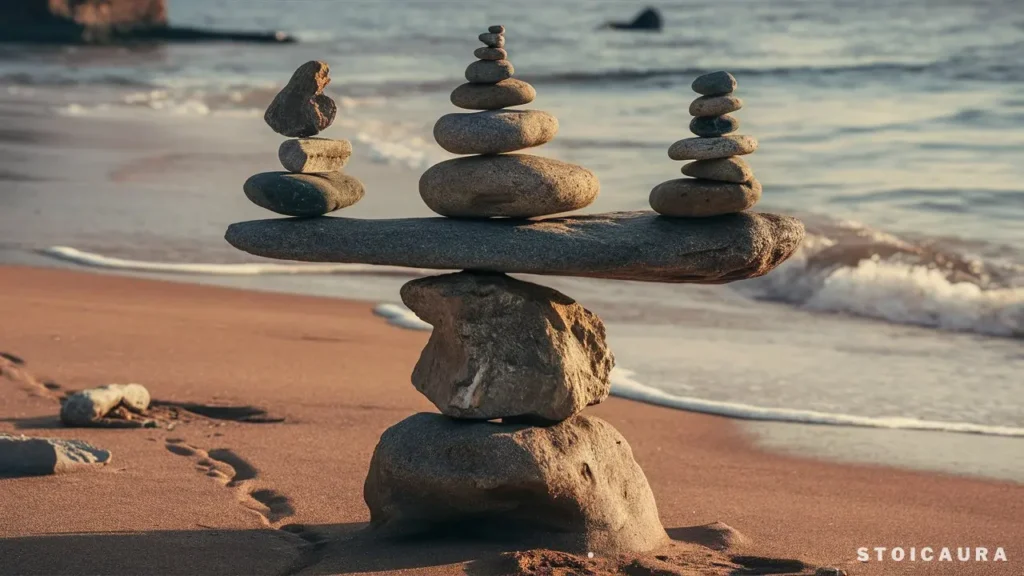
Introduction
Ever feel like you’re walking a tightrope, balancing personal happiness and daily responsibilities, and just one gust of wind could send everything tumbling? In the constant juggle of life, maintaining equilibrium can seem like a Herculean task. But what if there was a way to steady the scales from the inside out? Enter the world of Stoicism—a philosophy that might conjure images of unemotional sages, but is actually about finding profound balance and harmony amidst life’s turbulence.
Stoicism teaches us that true balance isn’t about external conditions, but about cultivating an inner stability that can weather any storm. In this article, we’ll delve into how adopting a Stoic personality can guide you to a place of inner peace and balance, transforming the way you navigate the ups and downs of everyday life. Ready to find your center? Keep reading, and let’s discover the path to harmony together.
Unveiling the Stoicism Personality: Your Key to a Balanced Life
Exploring the Stoicism Personality could be your golden ticket to achieving a more balanced and fulfilling life. This philosophical approach is not about denying feelings or toughing it out alone; instead, it emphasizes understanding and controlling one’s reactions to external circumstances to maintain an inner equilibrium. Think of it as learning the art of not letting the ups and downs of life shake your core. For instance, when faced with a setback, instead of spiraling into stress or negativity, adopting a Stoicism Personality means assessing the situation calmly, extracting valuable lessons, and moving forward with resilience.
This approach to life encourages us to focus on what we can control—our actions and attitudes—while accepting what we cannot change. This key principle of Stoicism not only reduces everyday stress but also greatly enhances personal happiness by aligning one’s expectations with reality. Plus, it cultivates a practical wisdom that comes in handy when making decisions, big or small, ensuring that you act in accordance with your deepest values and long-term goals.
By integrating the principles of the Stoicism Personality into your daily life, you not only foster a robust emotional foundation but also develop the agility to adapt gracefully to life’s unpredictabilities. It’s about more than just enduring life; it’s about thriving in it, regardless of the external chaos. In essence, Stoicism equips you with the tools to balance your emotions and actions in a way that promotes peace, contentment, and a deep-seated resilience. This isn’t just philosophy—it’s a practical route to a more balanced life.
Mastering Emotions with Stoicism: Techniques for Emotional Equilibrium
Mastering your emotions doesn’t mean suppressing them; rather, it’s about achieving a kind of emotional equilibrium that allows you to respond to life’s challenges with clarity and grace. This is where the Stoicism Personality shines. Stoicism teaches us that while we can’t control what happens to us, we can control how we react. By adopting Stoic principles, you learn to view situations objectively, which prevents emotions from overpowering your decision-making process. For example, if you’re cut off in traffic, instead of succumbing to rage—which is both stressful and unhelpful—a Stoic approach would have you acknowledge the irritation but choose not to let it dictate your behavior.
The Stoicism Personality involves techniques like the ‘dichotomy of control’, where you differentiate between what’s in your control and what isn’t. This technique alone can significantly reduce frustration by helping you focus on your reactions, which you can manage, rather than on external events, which you often cannot. Another useful Stoic practice is ‘negative visualization’, which involves imagining the worst-case scenario in a calm and rational way to diminish the fear or anxiety associated with it.
Implementing these Stoic strategies helps build emotional resilience. It trains you to remain composed and maintain your serenity, not through emotional suppression but through understanding and managing your feelings more effectively. The Stoicism Personality isn’t just about coping with life’s lows; it’s about enhancing the highs by remaining emotionally balanced and present in all situations. This approach doesn’t just alter how you handle emotions; it transforms your entire perspective, fostering a life of tranquility and empowerment.

The Stoic’s Daily Routine: Simple Practices for Maintaining Inner Harmony
Incorporating the Stoicism Personality into your daily routine can be a straightforward and immensely rewarding way to maintain inner harmony, even amidst life’s chaos. Stoicism isn’t about grand gestures but rather about the simple, consistent practices that align your day with serenity and purpose. For example, starting your morning with a few minutes of reflection can set a calm, thoughtful tone for the day. This could involve contemplating what you’re grateful for or reminding yourself of your ability to handle whatever the day may bring. Such practices root your mindset in positivity and resilience, essential components of the Stoicism Personality.
Midday, when tensions typically peak, taking a moment to reconnect with Stoic principles can be vital. This might look like a brief meditation where you refocus on what’s within your control, allowing you to let go of unnecessary stressors and realign with your core values. It’s about not getting swept up in the busyness but rather maintaining a steady, composed demeanor.
Ending your day with reflection is another key Stoic practice. Review the day’s events, assess your responses, and consider how they align with Stoic virtues such as wisdom, justice, courage, and moderation. This not only helps in winding down but also in learning and growing from each day’s experiences.
These simple Stoic practices don’t require much time, yet they significantly contribute to developing a strong, balanced Stoicism Personality. By embedding these routines into your daily life, you cultivate a powerful sense of inner harmony that enhances your ability to thrive, regardless of external circumstances.
Stoic Responses to Modern Stressors: Achieving Peace Amid Chaos
In today’s fast-paced world, where stress seems as common as coffee, embracing a Stoicism Personality can be your secret weapon to achieving peace amid chaos. Stoicism teaches that while we may not control external events, we can master our reactions to them, transforming our experience of stress and disorder. For instance, when faced with a high-pressure deadline at work, instead of spiraling into panic, a Stoic approach would encourage you to focus on managing your tasks efficiently, one step at a time, maintaining a calm mindset throughout.
This philosophy doesn’t just apply to work but also to personal challenges, like dealing with a difficult family member. Here, the Stoicism Personality advocates for empathy and understanding rather than confrontation or avoidance. By choosing to respond with patience and seeking to understand the other person’s perspective, you not only diffuse potential conflicts but also cultivate deeper relationships.
Moreover, Stoics utilize techniques like mindfulness and reflective journaling to detach from the immediacy of stressful situations, allowing a broader perspective that highlights solutions rather than problems. This helps in not getting overwhelmed by the ‘noise’ of life and keeping your inner peace intact.
Adopting a Stoicism Personality isn’t about suppressing emotions or ignoring life’s pressures; it’s about developing resilience and clarity that guide you through life’s storms. By practicing Stoic principles, you learn to stay grounded and composed, turning everyday stressors into opportunities for growth and peace. This proactive stance is empowering, turning what could be disturbances into moments for practicing serenity and strength.

The Enduring Satisfaction of Stoic Living: Cultivating a Contented Mind
Adopting a Stoicism Personality can lead to a deeply satisfying way of life, characterized not by fleeting pleasures but by enduring contentment. Stoicism teaches that true satisfaction doesn’t come from external achievements or possessions, but from cultivating a contented mind. This ancient philosophy encourages us to appreciate what we have and to focus on what’s truly important—our values, our behavior, and our response to life’s challenges. For example, imagine facing a sudden financial setback. While the initial reaction might be panic or despair, a Stoicism Personality guides you to view this challenge as an opportunity to practice resilience and resourcefulness, shifting the focus from loss to growth.
This approach extends to everyday interactions and personal goals. Stoics find satisfaction in self-improvement and in contributing to the well-being of others, rather than competing for status or material gain. They measure success by their ability to remain true to their principles, regardless of external circumstances. This mindset not only reduces stress and anxiety but also enhances life satisfaction, as each day is lived according to deeply held values.
Moreover, practicing Stoicism Personality involves regular reflection, which reinforces a sense of gratitude and acceptance. By examining your thoughts and actions daily, you align more closely with Stoic ideals, gradually transforming your outlook and enhancing your overall well-being. This continuous growth fosters a profound sense of fulfillment that is both robust and resilient, making Stoic living not just sustainable but deeply rewarding.
Conclusion
Cultivating a Stoic personality is not about suppressing emotions or becoming indifferent to the world. Instead, it’s about developing a resilient inner strength and wisdom that allows us to navigate life’s inevitable challenges with grace and composure. By focusing on what we can control, practicing virtue, and accepting what we cannot change, we pave the path toward inner harmony. The journey towards Stoicism is a continuous one, requiring practice and reflection, but the rewards are profound: a life of greater meaning, resilience, and inner peace.
Start your journey today:
- Reflect: Consider which Stoic principles resonate most with you and how you can integrate them into your daily life.
- Read: Explore the works of Stoic philosophers like Seneca, Marcus Aurelius, and Epictetus.
- Practice: Engage in mindfulness exercises, journaling, or negative visualization to strengthen your Stoic mindset.
- Connect: Join online communities or find local Stoic groups to share your experiences and learn from others.
Remember, the path to inner balance is a personal one, and Stoicism offers a compass to guide you. Take the first step today and discover the transformative power of this timeless philosophy.







